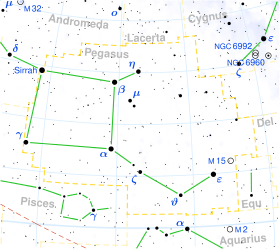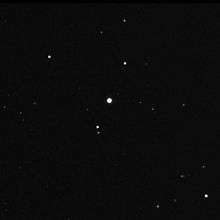HD 209458
 HD 209458 (circled) in the constellation Pegasus. | |
| Observation data Epoch J2000 Equinox J2000 | |
|---|---|
| Constellation | Pegasus |
| Right ascension | 22h 03m 10.8s[1] |
| Declination | +18° 53′ 04″[1] |
| Apparent magnitude (V) | 7.65[1] |
| Characteristics | |
| Spectral type | G0V[1] |
| Apparent magnitude (B) | 8.24[1] |
| Apparent magnitude (K) | 6.3[1] |
| B−V color index | +0.574 ±0.014[2] |
| Variable type | EP[3] |
| Astrometry | |
| Radial velocity (Rv) | -14.8[1] km/s |
| Proper motion (μ) | RA: 28.90[1] mas/yr Dec.: -18.37[1] mas/yr |
| Parallax (π) | 21.24[1] ± 1.00[1] mas |
| Distance | 154 ly (47.1 pc) |
| Absolute magnitude (MV) | 4.28 ±0.10[2] |
| Details | |
| Mass | 1.13 -0.02+0.03[4] M☉ |
| Radius | 1.14 -0.05+0.06[4] R☉ |
| Luminosity | 1.61 L☉ |
| Temperature | 6000 ±50[2] K |
| Metallicity | 0.00 ±0.02[2] |
| Rotation | 14.4 days |
| Age | (4 ± 2) × 109[2] years |
| Other designations | |
| Database references | |
| SIMBAD | data |
| Exoplanet Archive | data |
| Extrasolar Planets Encyclopaedia | data |
HD 209458 is an 8th-magnitude star in the constellation Pegasus. It is a G0V star, and is thus very similar to the Sun. Because it is located at a distance of about 150 light years, it is not visible to the unaided eye. With good binoculars or small telescope it should be easily detectable.[1]

In 1999, two teams working independently (one team consisted of astronomers at the Geneva Observatory, the Harvard-Smithsonian Center for Astrophysics, and the Wise Observatory; the second group was the California and Carnegie Planet Search team) discovered an extrasolar planet orbiting the star by using the radial velocity planet search method. Soon after the discovery, separate teams led by David Charbonneau and Gregory W. Henry were able to detect a transit of the planet across the surface of the star making it the first known transiting extrasolar planet.[5] The planet received the designation HD 209458 b.
Because the planet transits the star, the star is dimmed by about 2% every 3.5 days making it an extrinsic variable. The variable star designation for HD 209458 is V376 Pegasi. It is the prototype of the variable class "EP" in the General Catalogue of Variable Stars, defined as stars showing eclipses by their planets.[3][6]
Planetary system
HD 209458 b is an extrasolar planet that orbits the Sun-like star HD 209458 in the constellation Pegasus. Spectroscopic studies first revealed the presence of a planet around HD 209458 on November 5, 1999. The planet is now under even more public scrutiny with the announcement that its atmosphere contains water vapor. Astronomers had made careful photometric measurements of several stars known to be orbited by planets, in the hope that they might observe a dip in brightness caused by the transit of the planet across the star's face. This would require the planet's orbit to be inclined such that it would pass between the Earth and the star, and previously no transits had been detected.
Travis Barman at Lowell Observatory in Flagstaff, Arizona analyzed the emission spectrum of this planet, and believes that its atmosphere contains water,[7] although previous research[8] suggests that the atmosphere is composed mostly of silicate clouds.
| Companion (in order from star) |
Mass | Semimajor axis (AU) |
Orbital period (days) |
Eccentricity | Inclination | Radius |
|---|---|---|---|---|---|---|
| b | 0.69 ± 0.05 MJ | 0.045 | 3.52474541 ± 0.00000025 | 0.00 | — | — |
References
- 1 2 3 4 5 6 7 8 9 10 11 12 "SIMBAD query result: V* V376 Peg -- Variable Star". Centre de Données astronomiques de Strasbourg. Retrieved 2009-05-17.
- 1 2 3 4 5 Tsevi Mazeh, et al. (2000). "The Spectroscopic Orbit of the Planetary Companion Transiting HD 209458" (PDF). The Astrophysical Journal. 532 (1): L55–L58. arXiv:astro-ph/0001284
 . Bibcode:2000ApJ...532L..55M. doi:10.1086/312558.
. Bibcode:2000ApJ...532L..55M. doi:10.1086/312558. - 1 2 "GCVS query result: V376 Peg". General Catalog of Variable Stars. Sternberg Astronomical Institute, Moscow, Russia. Retrieved 2009-05-17.
- 1 2 Takeda; et al. (2007). "Structure and Evolution of Nearby Stars with Planets. II. Physical Properties of 1000 Cool Stars from the SPOCS Catalog". The Astrophysical Journal Supplement Series. 168 (2): 297–318. arXiv:astro-ph/0607235
 . Bibcode:2007ApJS..168..297T. doi:10.1086/509763.
. Bibcode:2007ApJS..168..297T. doi:10.1086/509763. - ↑ Charbonneau; et al. (2000). "Detection of Planetary Transits Across a Sun-like Star". The Astrophysical Journal Letters. 529 (1): L45–L48. arXiv:astro-ph/9911436
 . Bibcode:2000ApJ...529L..45C. doi:10.1086/312457.
. Bibcode:2000ApJ...529L..45C. doi:10.1086/312457. - ↑ Samus, N. N. (2009). "GCVS Variability Types and Distribution Statistics of Designated Variable Stars According to their Types of Variability". Retrieved 2010-08-02.
- ↑ Barman (2007). "Identification of Absorption Features in an Extrasolar Planet Atmosphere". The Astrophysical Journal Letters. 661 (2): L191–L194. arXiv:0704.1114
 . Bibcode:2007ApJ...661L.191B. doi:10.1086/518736.
. Bibcode:2007ApJ...661L.191B. doi:10.1086/518736. - ↑ L. J. Richardson, et al. (2007). "A spectrum of an extrasolar planet". Nature. 445 (7130): 892–895. arXiv:astro-ph/0702507
 . Bibcode:2007Natur.445..892R. doi:10.1038/nature05636. PMID 17314975.
. Bibcode:2007Natur.445..892R. doi:10.1038/nature05636. PMID 17314975.
External links
- "HD 209458". Exoplanets. Retrieved 2009-05-17.
Coordinates: ![]() 22h 03m 10.8s, 18° 53′ 04″
22h 03m 10.8s, 18° 53′ 04″